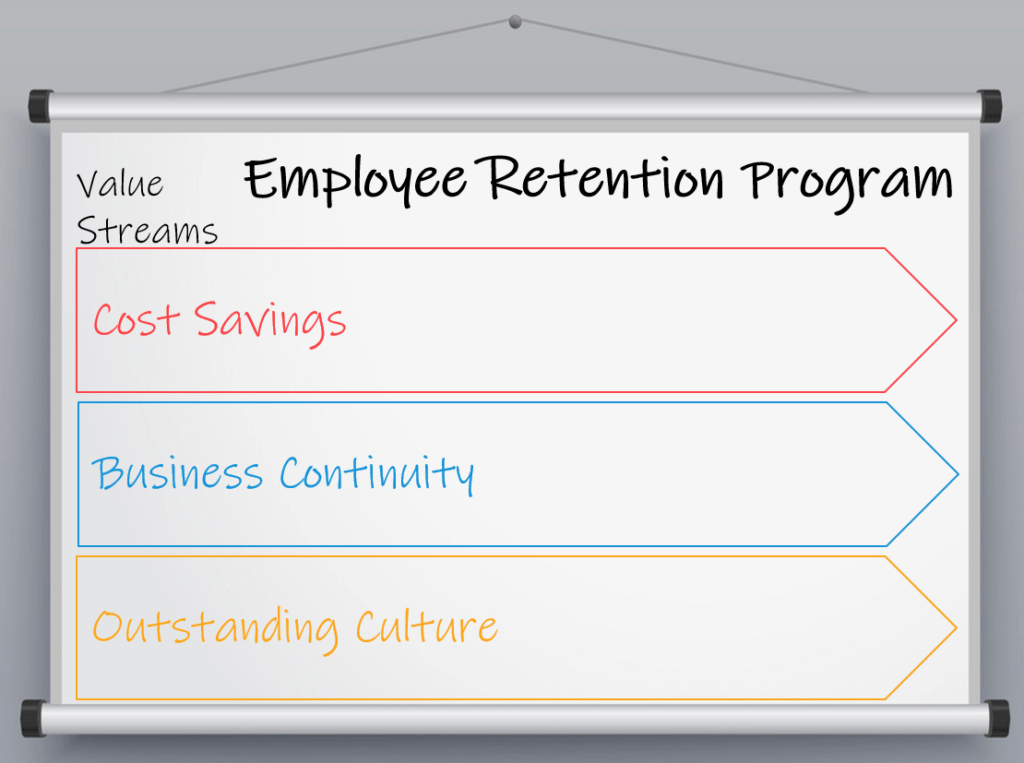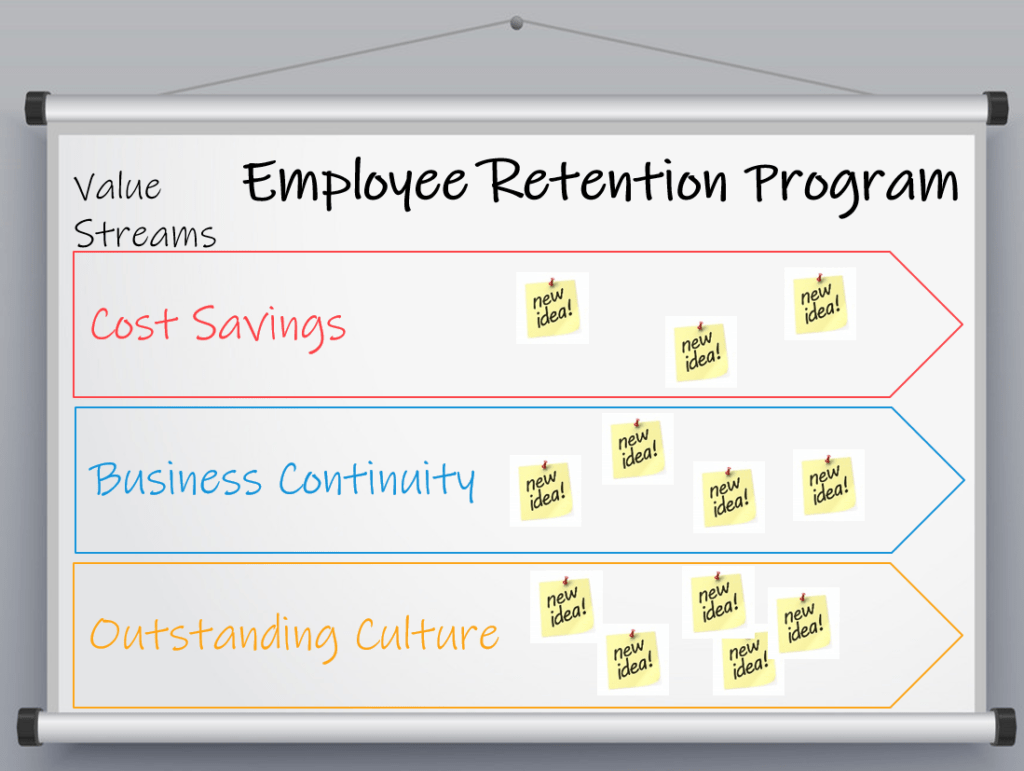PLAY Introduction
Ideation is the creative process of generating, developing, and communicating new ideas, where an idea is understood as a basic element of thought that can be either visual, concrete, or abstract. Ideation comprises all stages of a thought cycle, from innovation, to development, to actualization. This play will help you move through all stages and deliver an idea that works!
PEOPLE
2-10 depending on the size of the team. If it becomes larger than 10 people consider breaking out into smaller groups.
TIME
30-60 Minutes. No one wants to be in a meeting longer than needed. Try to keep it short and sweet.
NINJA LEVEL
Novice to Master. Anyone can develop great ideas!
PREP WORK
PEOPLE
This is key to successful meetings. Make sure all key stakeholders are on the invite, the decision makers and those funding the product. You need their buy-in from the start!
PLACE
Virtually or in-person it is critical that everyone has face-time with each other. So make sure that if attending virtually that everyone can connect in video chat. You will also need to share ideas, so a whiteboard is important and a space that fosters creativity and innovation.
THE PLAY
All of our plays are five steps or less! However, you may need to run multiple plays to get the most out of this one. Don’t worry – you can do it! Learn the play, rehearse it regularly, apply it in the field and debrief on the outcomes. If it worked well, use it again; if it didn’t, find out why. Are there new factors in the system you need to consider, or do you just need to keep practicing? If you need help or have questions on this play, contact us!
01
SET THE STAGE
Who are the players?
Every winning team knows which players to have on the field and what talent you need on the ready. To successfully deploy this play you will need the following roster:
![]() Meeting Facilitator: Likely this is you! But you don’t have to do it alone, ask a friend (think of it like a football team that has a coach for different parts of the team). Skills needed:
Meeting Facilitator: Likely this is you! But you don’t have to do it alone, ask a friend (think of it like a football team that has a coach for different parts of the team). Skills needed:
- Keep the team focused on the goal!
- Foster a positive and creative space for all
- Organized and prepared to run play
![]() Product Manager: A product manager is a professional role that is responsible for the development of products for an organization, known as the practice of product management. Product managers own the business strategy behind a product, specify its functional requirements, and generally manages the launch of features. Skills needed:
Product Manager: A product manager is a professional role that is responsible for the development of products for an organization, known as the practice of product management. Product managers own the business strategy behind a product, specify its functional requirements, and generally manages the launch of features. Skills needed:
- Ability to balance business and user needs
- Attention to detail
- Curiosity to explore new ideas
- Ability to deliver factual data in-time
- Empathy for customers
- Ability to build strong relationships with other teams
- Understanding of necessary data structures
- Informed about the technical implications of the platforms being used
- Ability to tailor communications to different stakeholders
![]() Product/System/Business Unit Owners: These are decision makers. They can make the call on what changes will happen or authorize a strategy. Skills needed:
Product/System/Business Unit Owners: These are decision makers. They can make the call on what changes will happen or authorize a strategy. Skills needed:
- Change agent. Supportive and enthusiastic about improvements.
- Supportive of the team and SMEs!
- Committed and engaged in the product.
![]() Subject Matter Experts (SMEs): A SME (pronounced S-Mee) is critical for this play. They will help drive the team to a shared understanding of what is needed to win. Skills needed:
Subject Matter Experts (SMEs): A SME (pronounced S-Mee) is critical for this play. They will help drive the team to a shared understanding of what is needed to win. Skills needed:
- Specific domain knowledge, narrow and deep rather than broad and shallow.
- Communication and team collaboration. They must be able to share with others the knowledge they have on a particular subject.
![]() Stakeholders: Key members of the team who can help drive direction of the final product. This can be internal or external players. They might have a specialized skill set but they are interested in being part of the winning team. For the initial meeting this does not need to include the entire team, but be sure that each group has representation. Skills needed:
Stakeholders: Key members of the team who can help drive direction of the final product. This can be internal or external players. They might have a specialized skill set but they are interested in being part of the winning team. For the initial meeting this does not need to include the entire team, but be sure that each group has representation. Skills needed:
- Vested interest in the outcome
- Commitment to seeing it through completion (no fair weather fans)
- Engaged and believes the team can win!
Get the field ready!
![]() Schedule the meeting in advance. Don’t wait until the last minute to schedule the meeting. You want people to be excited about it but not so last minute that they have no time to prepare.
Schedule the meeting in advance. Don’t wait until the last minute to schedule the meeting. You want people to be excited about it but not so last minute that they have no time to prepare.
![]() Include an agenda. Set expectations – this will help keep your meeting on track. Include schedule and any prep work needed. Also let them know if it is okay to invite others or not. Remember that if you have to many people in the meeting, it will be difficult to facilitate brainstorming sessions without breaking out into smaller groups.
Include an agenda. Set expectations – this will help keep your meeting on track. Include schedule and any prep work needed. Also let them know if it is okay to invite others or not. Remember that if you have to many people in the meeting, it will be difficult to facilitate brainstorming sessions without breaking out into smaller groups.
![]() Prep the room. Arrive early and get ready. If it is in a physical room, get whiteboards ready, enough chairs for everyone, water and snacks are always a hit! If virtually, a central location for notes, brainstorms and follow-up items. Test connectivity in the meeting room and make sure there is enough seats for all participants.
Prep the room. Arrive early and get ready. If it is in a physical room, get whiteboards ready, enough chairs for everyone, water and snacks are always a hit! If virtually, a central location for notes, brainstorms and follow-up items. Test connectivity in the meeting room and make sure there is enough seats for all participants.
02
CORE ACTIVITIES
INNOVATION
The first step in innovation is to come up with a vision statement of what you would like to achieve. A vision statement gives direction and determines purpose. Lots will confuse this with a mission statement, but for product development it is important to separate ‘what and when’ (vision statement) from ‘why’ (mission statement). A vision statement is the anchor point of any strategic plan.
There are a few common rules that pretty much every good Vision Statement will follow:
- They should be short – two sentences at an absolute maximum. It’s fine to expand on your vision statement with more detail, but you need a version that is punchy and easily memorable.
- They need to be specific to your product and business and describe a unique outcome that only you can provide. Generic vision statements that could apply to any product or project won’t do. This will need to be something the team can work on specific to your product.
- Do not use words that are open to interpretation. For example, saying you will ‘reduce customer service calls’ or ‘improve customer experience’ doesn’t actually mean anything unless you specify what it actually looks like.
- Keep it simple enough for people both inside and outside your organization to understand. No technical jargon, no metaphors, and no business buzz-words if at all possible!
Okay so how to write a vision statement, right? Gather the team around a table and get ready to brainstorm.
- Pass each team member large sticky notes, preferably in different colors. If you are meeting virtually, limit each idea to one or two sentences.
- Write the main focus on the whiteboard in the center and circle it.
- You may also narrow ideas by subject matter, for example, this may be vision statements around only one area of the product. If you are building a website, you may want to brainstorm around the sign-up process rather than the entire website.
- Set the timer for 15 minutes and ask each person to come up with 2-5 submissions answering the following question, “What do we want to do (as it relates to the whiteboard focus), and when do we want to do it by?”.
- To help get the creative thinking going, you may want to provide a template for direction. Such as, For [our target customer], who [customer’s need], the [product] should [product feature or function] that [unique benefits and selling points] by [achievable timeframe].
- Ask team to place stickies on whiteboard around objective, grouping similar concepts together.
- Move around room asking each person to give a brief (5 minutes or less) overview of stickies on board.
- Take a team vote on the vision statement that best represents the objective and time line for the product. You may need to revise or combine multiple ideas to get to the best statement.
The vision statement should give the team a jumping point for diving deeper into product features and functionality that will answer questions around target group, needs, product and value.

DEVELOPMENT
Value streams represent the solutions that provide a continuous flow of value to a customer. This can be done for processes, development and also product ideation. To identify the value streams for your product:
- Clear the whiteboard and write your Vision Statement or concept at the top of the whiteboard.
- Ask the team, “how will this benefit the organization?” Pass sticky notes to team and ask for top 3 from each person
- Keep answers high level, for example, Reduce costs, Increase revenue, Improve customer experience, Expand sales markets, Higher conversion, Competitive advantage, etc.
- Ask team to place stickies on whiteboard under mission statement, grouping similar concepts together.
- Take three most common ideas, or vote on top three if multiple ideas tied
- Create value streams of the top three ideas
Your board might look something like this:
ACTUALIZATION
Now the fun begins! You have your vision statement and value streams. This is where you will get the ideas on what to do going. Here’s how:
- Everyone gets a standard size sticky note pad
- Goal is 1-3 ideas per person
- Idea must result in value creation
- Set timer! 5-10 minutes to come up with ideas
- After timer, each person adds their sticky note in the appropriate value stream, group similar ideas together
Your board will look similar to this:
Last …The Pitch
- Each person must pitch their ideas in front of the team
- 1-3 minutes TOTAL (all ideas)
- Uninterrupted time – no questions or input from the team
- Basic concept, how it creates value, and what it might cost to do – for EACH idea
- After completion – thank the team
- Team round of applause
Now you have a list of ideas for your product development that deliver value and align to the vision statement!
Need help prioritizing ideas? See our Prioritizing Work play in Step 3.
03
 TEAM HUDDLE
TEAM HUDDLE
Time to run the Team Huddle play. Ask the team the following questions and then take a vote. Keep follow-up questions to a minimum and capture any issues raised as an offline follow-up (and be sure to follow-up).
Understand the play?
![]() The play was understood and I asked any questions in time!
The play was understood and I asked any questions in time!
![]() I’m not sure I understand and I have some questions …
I’m not sure I understand and I have some questions …
![]() I did not understand the play or my part in it.
I did not understand the play or my part in it.
Did you get in the game?
![]() Yes, I made my moves and was in the right place at the right time!
Yes, I made my moves and was in the right place at the right time!
![]() I’m not sure I understand what I was supposed to do …
I’m not sure I understand what I was supposed to do …
![]() I kept the bench warm and watched from the sidelines.
I kept the bench warm and watched from the sidelines.
Ready for what’s next?
![]() Yes, I know the game plan and ready to win!
Yes, I know the game plan and ready to win!
![]() I’m not sure what’s next or if I am involved …
I’m not sure what’s next or if I am involved …
![]() No clue what’s next and would rather sit it out.
No clue what’s next and would rather sit it out.
04
NEXT STEPS
Phew! The hard part is done! You might be tempted to go further and discuss the plan on how to implement all these ideas – but don’t! Instead congratulate the team on a very successful and productive ideation meeting!

![]() Schedule the next meeting where the team will take the next steps in prioritizing the work. Set a regularly reoccurring meeting cadence so that the team stays engaged and is front of mind.
Schedule the next meeting where the team will take the next steps in prioritizing the work. Set a regularly reoccurring meeting cadence so that the team stays engaged and is front of mind.
![]() Publish your notes in a central repository that the team has access to immediately. Even better if it is someplace that the team can add comments or collaborate on. Keep the creative chat going!
Publish your notes in a central repository that the team has access to immediately. Even better if it is someplace that the team can add comments or collaborate on. Keep the creative chat going!
05
IT’S A WRAP
You did it! Now just a few follow-up items:
- Reflect on the play. Ask yourself how it went? What could have gone better, what could have gone worse? In sports this is watching the game again to see any plays that could have been better. Update your playbook. Build feedback loops that help you see what’s working; what’s not; and how to continue to develop the playbook by learning, adapting and iterating constantly as situations change and new challenges arise.
- Contribute to the community of Playbook.Ninja. Sign-up for an account and receive updates on when new plays are added and help others by commenting on the plays with what worked or your experience.
Thank you for being a Playbook.Ninja
![]()




 TEAM HUDDLE
TEAM HUDDLE